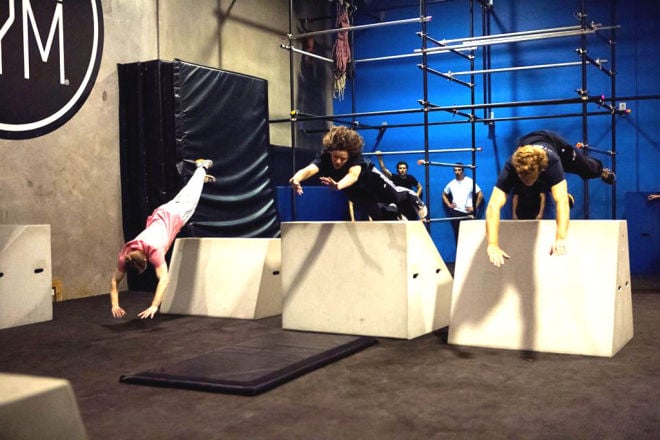How To Fall Over Without Hurting Yourself: Five Practical Lessons From A Professional Stunt Man
The big one? Get insurance.


Open Your City with
We’ve teamed up with Heineken to introduce you to some men and women who have chosen to go beyond their borders, challenge the status quo, say ‘why not?’ instead of ‘it can’t be done’ — and as a result have made the world a more interesting place for the rest of us. For more people worth watching, head here.
—
If you’ve seen The Great Gatsby, The Matrix, or Babe: Pig in the City, then you’ve seen some of Tony Lynch’s work. With almost thirty years of experience in the stunt industry, Lynch’s resume is as impressive as it is extensive.
The pathway into stunts as a career is a reflection of the job itself: tumultuous and time consuming. Lynch is one of around thirty stunt coordinators in Australia, the highest grade available in the industry, and a position that takes twenty years to achieve.
Starting his career in Adelaide in 1985, he moved to Sydney in the late ‘80s and after a difficult few years, which involved living in his car for six months, has been working pretty consistently since 1993. He has over a hundred credits to his name, including projects like Two Hands, The Wolverine, Superman Returns, Ned Kelly, and Moulin Rouge. For the last two years he’s taken his knowledge of screen stuntwork a step further by running Stunt Gym in Brookvale, which provides structured training to current and incoming stunt performers.
I chatted to him about flipping cars, setting yourself on fire, and getting the right insurance — and came out the other side with five pieces of practical advice. Before continuing however I just want to say: do not try this at home. But if you do find yourself fighting, falling or doing Parkour anyway, then the following may come in useful.
–
If You Get In A Fight, Don’t Fight Like They Do In The Movies

While it may look good in a film to fly-kick a mugger in the chest before embarking on a rooftop chase which culminates in a three minute martial arts extravaganza, you may have already guessed that perhaps this is not the best approach to take in real life. In reality, most screen scuffles are entirely impractical. “It’s a performance.” Lynch tells me. “It’s completely fake. You often do the opposite of what you would really do in a real fight or situation. “
–
Try To Fall On Your Knees

Through his work at Stunt Gym, Lynch is involved in training new performers. When I asked about the best way to fall over, his reply was “If you just fall over on the street, the safest way is to kind of drop. Collapse down on to your knees, and then get your hands down.” He pauses. “It would be easier to demonstrate it, and would make more sense. Break part of the fall with your knees, then the rest of the fall with your hands.”
Please keep in mind that this is for if you are already falling, not just if you feel like it. Really. Don’t try this at home.
–
Doing Parkour? Get Insured

Lynch worked as a stunt coordinator on the recently released Felony, and if you’ve seen it, then you’ll remember a pretty impressive Parkour sequence near the beginning. Parkour in and of itself is pretty dangerous, so if you’re practicing in public you don’t want to add legal risks on top of the physical ones. Lynch mentions a policy that practitioners can consider, run through an association called Duck for Cover. “They cover a lot of circus performers, buskers and street performers, so Parkour practitioners can get that policy. It basically means that if they’re performing in the street and they land on top of somebody, then they’re covered for public liability.”
–
Stunt Performers Equal Good Drivers

One of the most difficult stunts Lynch has performed was flipping a car at night in a paddock. “If you’re flipping a car, it’s crucial to hit the ramp at the right place” he explains. In this case, lining up the car was extremely challenging due to the fact it was night time, and that the paddock was sloped. “It never sounds exciting” he adds. “People are hoping for an answer like you had to jump out of a helicopter on to a wing of an aeroplane.”
Stunt experience does however create an interesting duality. “When you’re driving around on the road you drive like an old Grandma” Lynch laughs. “Stunt drivers usually are pretty sensible because we’ve got nothing to prove. In stunts we have that outlet in training and in work. You get all that out.”
–
Want To Be A Movie Star? Don’t Choose Stunts As A Career

If you’re considering a career in stunts, it’s important to walk in knowing that it’s a huge time commitment. It will take at least twelve months from the day you start training before you’d be in a position to qualify for the first level of grading. Even then, Lynch explains, “you never walk into a stunt career right after you get graded. To get a job you need to do a great deal of networking and be persistent. It’s a very difficult, tedious task.”
You also need to train like crazy; Lynch explains that in order to be the very best you could be, you’d ideally train for six hours a day. Obviously this is not a very realistic goal, so “for a stunt performer who works regularly you would have to train for a minimum two hours a day. It’s not all about doing push-ups and pull-ups, it’s about maintaining physical conditioning and learning skills.”

It requires a lot of commitment and enthusiasm; Lynch reckons “there are no shortcuts or overnight success stories in stunts”. But for those who put in the time and effort, they get a rewarding, highly-paced and endlessly interesting career. If you’re going to work, you may as well do something you love.
–
Elizabeth Flux is the editor of Voiceworks, and has been published in Film Ink, Metro, The Punch, and Lip Magazine. She tweets terrible puns @ElizabethFlux.